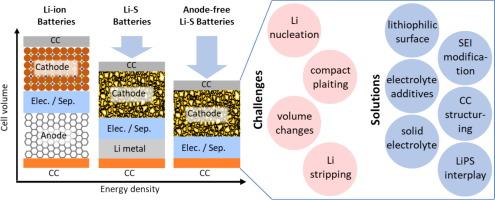Rising Anode-Free Lithium-Sulfur batteries
IF 13.3
1区 工程技术
Q1 ENGINEERING, CHEMICAL
引用次数: 0
Abstract
Anode-free batteries (AFBs) represent a paradigm shift in battery architecture, eschewing conventional metal anodes in favor of current collectors (CCs). This innovative approach promises heightened energy densities, reduced manufacturing costs, and diminished environmental impact compared to traditional metal batteries. A particularly promising subset of AFBs are anode-free lithium-sulfur batteries (AFLSBs), which have garnered substantial attention due to their exceptional theoretical energy density, sulfur’s abundance, and potential cost advantages. This mini-review encapsulates the recent studies in AFLSB research, elucidating key challenges and breakthroughs. The absence of a lithium (Li) metal anode mitigates safety concerns and maximizes cell energy density. However, successful Li plating on the CC necessitates a lithiophilic surface and a meticulously engineered solid electrolyte interphase (SEI). To surmount these obstacles, researchers are exploring a plethora of strategies, encompassing surface modifications, electrolyte additives, and cathode engineering. Promising results have been realized through metal coatings on CCs, utilization of 3D CCs, and incorporation of lithium polysulfide scavengers. Additionally, quasi-solid-state electrolytes offer enhanced safety and potentially augmented AFLSB performance. AFLSB research is a rapidly developing field with significant advancements being made. These breakthroughs hold the potential to usher in a new era of high-performance and sustainable energy storage solutions.


正在崛起的无阳极锂硫电池
无阳极电池(AFB)代表了电池结构的一种模式转变,它摒弃了传统的金属阳极,转而使用集流器(CC)。与传统金属电池相比,这种创新方法有望提高能量密度、降低制造成本并减少对环境的影响。无阳极锂硫电池(AFLSBs)是 AFBs 中特别有前途的一个子集,由于其出色的理论能量密度、硫的丰富性和潜在的成本优势,AFLSBs 已获得广泛关注。这篇微型综述概述了 AFLSB 研究的最新进展,阐明了关键挑战和突破。不使用锂(Li)金属阳极可减轻安全问题,并最大限度地提高电池能量密度。然而,要在 CC 上成功镀锂,必须要有亲锂表面和精心设计的固体电解质相(SEI)。为了克服这些障碍,研究人员正在探索多种策略,包括表面改性、电解质添加剂和阴极工程。通过在 CC 上进行金属涂层、利用三维 CC 以及加入多硫化锂清除剂,已经取得了可喜的成果。此外,准固态电解质可提高安全性,并有可能增强 AFLSB 的性能。AFLSB 研究是一个快速发展的领域,目前正在取得重大进展。这些突破有可能开创高性能和可持续储能解决方案的新时代。
本文章由计算机程序翻译,如有差异,请以英文原文为准。
求助全文
约1分钟内获得全文
求助全文
来源期刊

Chemical Engineering Journal
工程技术-工程:化工
CiteScore
21.70
自引率
9.30%
发文量
6781
审稿时长
2.4 months
期刊介绍:
The Chemical Engineering Journal is an international research journal that invites contributions of original and novel fundamental research. It aims to provide an international platform for presenting original fundamental research, interpretative reviews, and discussions on new developments in chemical engineering. The journal welcomes papers that describe novel theory and its practical application, as well as those that demonstrate the transfer of techniques from other disciplines. It also welcomes reports on carefully conducted experimental work that is soundly interpreted. The main focus of the journal is on original and rigorous research results that have broad significance. The Catalysis section within the Chemical Engineering Journal focuses specifically on Experimental and Theoretical studies in the fields of heterogeneous catalysis, molecular catalysis, and biocatalysis. These studies have industrial impact on various sectors such as chemicals, energy, materials, foods, healthcare, and environmental protection.
 求助内容:
求助内容: 应助结果提醒方式:
应助结果提醒方式:


